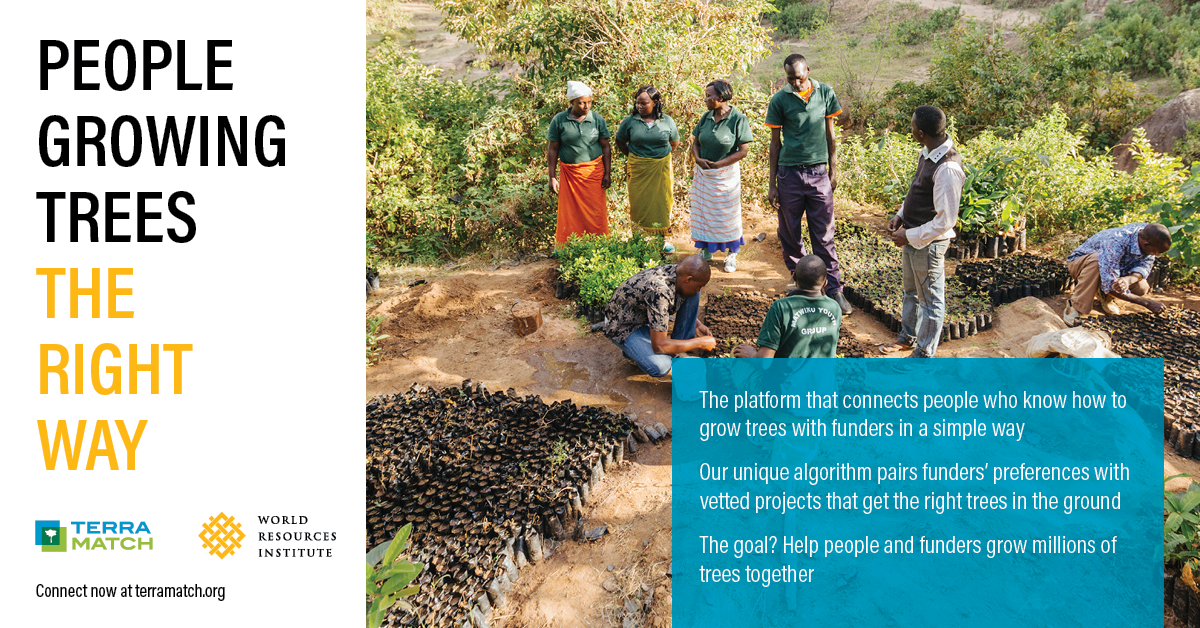
TerraMatch helps tree-growers access reliable funding to scale up, understand the fragmented market better, and showcase their work to a global audience.
Read more
Related articles for further reading
Connecting the People Growing A Trillion Trees the Right Way
By Aaron Minnick and Will Anderson
June 18th
Everyone is talking about trees. In January, the World Economic Forum founded the Trillion Trees initiative (1t.org), an effort to protect and grow enough trees to fight climate change and build healthy rural landscapes and economies. Around the same time, major private companies made their own pledges to grow hundreds of millions of trees.
This new momentum came after a disastrous year for the world’s trees. In 2019, the world lost 11.9 million hectares of tree cover in the tropics, the rough equivalent of 4 billion trees — an area the size of Honduras or the state of Pennsylvania.
The Trillion Trees initiative joins the existing, locally-led movement to restore degraded landscapes. Projects led by governments, NGOs and farmers have transformed large swaths of land in countries from Niger, where farmers have regreened 5 million hectares to little public recognition, to the United States, where the Forest Service has restored tens of millions of hectares of public land.
At the same time, funders have trouble finding trusted partners who can grow trees responsibly and on a large scale. Investors often don’t have accurate information about the local markets where tree growers operate. And when they do connect with growers, funders’ lack of on-the-ground experience can lead them to impose uninformed restrictions on projects and to push for an unsustainably low price per tree.
Poor Planning Leads to Failed Tree Planting
That’s partially why some high-profile tree-planting campaigns, which were poorly thought out and ignored the concerns of local people and experts, have failed spectacularly. Last year in Turkey, a government campaign planted 11 million saplings in one day, only to have 90% quickly die after no one invested in their care.
This kind of failure is not new. In Kenya in the 1970s, the mesquite tree was introduced to combat desertification, provide firewood and feed livestock. Kenya’s environment was too favorable, and the mesquite grew so aggressively that it out-competed native plants and devastated grazing land, harming the farmers and herders it was meant to help.
These failures are real, but they distract from the reasons why people grow trees, which bring tangible benefits to people near and far.
A Global Movement of Landscape Restoration Experts
Trees and other nature-based solutions help communities adapt to climate change and can provide up to 37% of the annual reductions in greenhouse gas emissions needed by 2030. Trees and forests stop erosion in its tracks, regulate water supplies, keep the soil fertile and boost crop yields. And for every $1 invested in tree restoration, people can earn up to $30 in direct benefits. Trees are key economic assets for people who build their livelihoods on the timber, fruit and other products that they provide.
That’s why businesses, NGOs and government agencies, especially in emerging economies, are looking for funding to invest in growing trees. In Africa, Malawi has developed a Youth Forest Restoration Programme which creates a path toward rural development and jobs. In Latin America, El Salvador spearheaded a UN resolution to declare 2021-2030 the Decade on Ecosystem Restoration and designed a first-of-its-kind sustainability index for restoration.
Many of these leaders have decades of experience and in-depth local knowledge. They grow trees the right way. They start with engaging local people, choose the right trees for the right places, build collaborative strategies that restore entire landscapes and economies, and nurture trees and measure progress. But these tree growers have no centralized place to contact and educate funders or build lasting partnerships to scale up their work.
Matching Investors to People Successfully Growing Trees
That’s where TerraMatch comes in. Backed by years of WRI research, TerraMatch is an online platform and mobile app that combines new excitement from the private sector with expertise from the global movement to restore degraded and deforested land.
Project developers around the world post detailed project plans, vetted by WRI, onto the TerraMatch platform. Each project pitch includes the species of trees involved, the historical survival rate of the project’s trees and the tree-grower’s method of restoration. Project developers explain the true costs of not just planting a tree, but growing it for years, including preparing the site, maintaining trees for years after planting, and measuring progress over time.
Funders post offers of their own, explaining what kinds of projects they hope to fund and how much money they can offer. Then, both parties search using TerraMatch’s algorithm and match.

Projects Realizing a Trillion Trees
With the TerraMatch approach, WRI has since 2018 moved more than $2 million from funders to project developers in nine countries. That includes AIDER, an NGO in Peru that has protected and restored more than 1.1 million hectares of forest in the Amazon. AIDER was looking for funding to expand its program to protect the biodiverse Tambopata National Reserve with a ring of sustainable and productive farms full of trees. Over three years, funder One Tree Planted has helped AIDER start growing more than 300,000 trees, transforming the lives of papaya and cocoa farmers while fighting climate change.
In Rwanda, grassroots organization ARCOS — a network of women-led cooperatives — received funding in 2018 to grow more than 40,000 trees to boost farmers’ crop yields and build food security. They are now scaling up their work to protect the threatened Gishwati Forest.
And since 2019, funding for over 25,000 trees grown by the Ghana’s Environmental Protection Agency has begun to revitalize the Tongo Hills to fight erosion and protect water sources. Through its Youth in Agriculture and Afforestation Program, Ghana can turn future funding into sustainable economic opportunities for the country’s young people.
Scaling Up the Tree and Landscape Restoration Economy
Governments, companies and communities have worked for a decade through the Bonn Challenge, and regional alliances AFR100 in Africa and Initiative 20×20 in Latin America and the Caribbean. Through this global movement to restore land, thousands of people are growing trees that will last. But they need funding to continue their work.
To support those goals, the Trillion Trees initiative has made impressive an impressive committment to restore land by growing trees. To avoid repeating past failures, and to build on existing successful projects, investors need to partner with local experts and ensure that these trees grow for decades. TerraMatch is one way that corporate leaders can create long-term partnerships that sustainably support entrepreneurs who are building the global landscape restoration economy.
We are calling on all tree-growers and funders to join TerraMatch and begin connecting. To get involved, head over to TerraMatch.org to apply for an account or to our public project page to get into the details. TerraMatch is available in English, French, Portuguese and Spanish. First posted at https://www.wri.org/blog/2020/06/growing-trillion-trees-right-terramatch